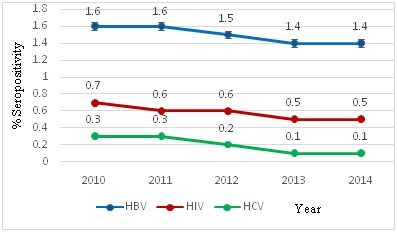Seroprevalance of hepatitis B Virus, human immunodeficiency virus and hepatitis C virus among blood donors: a retrospective study
Abstract
Background: Screening of life threatening transfusion-transmissible infections (TTIs), like Human Immunodeficiency Virus (HIV), Hepatitis B and Hepatitis C Virus (HBV and HCV) in blood donors is important to maintain transfusion safety.
Objective: To determine the prevalence of HBV, HIV and HCV in blood donors in Blood Bank of our hospital. Material and Methods: A retrospective analysis of 37,090 blood donors’ records was carried out over a period of five years from 2010 to 2014.
Results: Of the 37,090 donors, seroprevalence of HBV, HIV and HCV was 1.5%, 0.6% and 0.2% respectively.
Conclusion: Transfusion Transmitted Infections (TTIs) are important consideration for safe blood transfusion. The precise estimate of prevalence of viral infections in a group will help to monitor transfusion safety measures.
Downloads
References
2. Tsai JF, Jeng JE, Ho MS, et al. Effect of hepatitis C and B virus infection on risk of hepatocellular carcinoma: a prospective study. Br J Cancer. 1997;76(7):968-74.DOI:10.1038/bjc.1997.493
3. Allain JP, Thomas I, Sauleda S. Nucleic acid testing for emerging viral infections. Transfus Med. 2002 Aug;12(4):275-83.[pubmed]
4. Luban NL. Transfusion safety: Where are we today? Ann N Y Acad Sci. 2005;1054:325-41. doi:10.1196/ annals.1345.040.[pubmed]
5. Fathi Abed Al-Gani. Prevalence of HBV, HCV and HIV-1, 2 infections among blood donors in Prince Rashed Ben Al-Hassan Hospital in North Region of Jordan. Int J Biol Med Res 2011;2(4):912-916.
6. Zafar N. A survey of blood transfusion practices. J Coll Physicians Surg Pak 2000;10:90-2.
7. Isbister JP. Risk management in transfusion medicine. Transfus Med Rev. 1996 Jul;10(3):183-202.[pubmed]
8. Grgicevic D, Balija M, Pirc-Tiljak D, Mihaljevic´ I, Gjenero-Margan I, Zupancic´-Salek S. Decreasing risk of viral transfusion-transmitted diseases in Croatia. Croat Med J 2000;41:191-6.
9. Asif N, Kokher N, Ilahi F. Seroprevalence of HBV, HCV, and HIV infection among voluntary non remunerated and replacement donors in northern Pakistan. Pak J Med Sci 2004;20:24-8
10. Chandra T, Kumar A, Gupta A. Prevalence of transfusion transmitted infections in blood donors: an Indian experience. Trop Doct. 2009 Jul;39(3):152-4. doi: 10.1258/td.2008.080330.[pubmed]
11. Singh K, Bhat S, Shastry S. Trend in seroprevalence of Hepatitis B virus infection among blood donors of coastal Karnataka, India. J Infect Dev Ctries. 2009 Jun 1;3(5):376-9.[pubmed]
12. Bhattacharya P, Chandra PK, Datta S, Banerjee A, et al. Significant increase in HBV, HCV, HIV and syphilis infections among blood donors in West Bengal, Eastern India 2004-2005: exploratory screening reveals high frequency of occult HBV infection. World J Gastroenterol. 2007 Jul 21;13(27):3730-3.[pubmed]
13. Giri PA, Deshpande JD, Phalke DB, et al. Seroprevalence of transfusion transmissible infections among voluntary blood donors at a tertiary care teaching hospital in rural area of India. J Family Med Prim Care. 2012 Jan;1(1):48-51. doi: 10.4103/2249-4863.94452.[pubmed]
14. Chattoraj A, Behl R, Kataria VK. Infectious Disease Markers in Blood Donors. Med J Armed Forces India. 2008 Jan;64(1):33-5. doi: 10.1016/S0377-1237(08)80142-6. Epub 2011 Jul 21.[pubmed]
15. Lavanchy D. Hepatitis B virus epidemiology, disease burden, treatment, and current and emerging prevention and control measures. J Viral Hepat. 2004 Mar;11(2):97-107.[pubmed]
16. Singh B, Kataria SP, Gupta R. Infectious markers in blood donors of East Delhi: prevalence and trends. Indian J Pathol Microbiol. 2004 Oct;47(4):477-9.[pubmed]
17. Srikrishna A, Sitalakshmi S, Damodar P. How safe are our safe donors? Indian J Pathol Microbiol. 1999 Oct;42(4):411-6.[pubmed]
18. Arora D, Arora B, Khetarpal A. Seroprevalence of HIV, HBV, HCV and syphilis in blood donors in Southern Haryana. Indian J Pathol Microbiol. 2010 Apr-Jun;53(2):308-9. doi: 10.4103/0377-4929.64295.[pubmed]
19. National AIDS Control Organization & ICMR-National Institute of Medical Statistics (2018). HIV Estimations 2017: Technical Report. New Delhi: NACO, Ministry of Health and Family Welfare, Government of India. Pg 21.
20. Pahuja S, Sharma M, Baitha B, et al. Prevalence and trends of markers of hepatitis C virus, hepatitis B virus and human immunodeficiency virus in Delhi blood donors: a hospital based study. Jpn J Infect Dis. 2007 Nov;60(6):389-91.[pubmed]
21. Pallavi P, Ganesh C, Jayashree K, Manjunath G. Seroprevalence and Trends in Transfusion Transmitted Infections Among Blood Donors in a University Hospital Blood Bank: A 5 Year Study. Indian J Hematol Blood Transfus. 2011;27:1-6.
22. Singh B, Verma M, Kotru M, et al. Prevalence of HIV and VDRL seropositivity in blood donors of Delhi. Indian J Med Res. 2005 Sep;122(3):234-6.[pubmed]
23. Garg S, Mathur DR, Garg DK. Comparison of seropositivity of HIV, HBV, HCV and syphilis in replacement and voluntary blood donors in western India. Indian J Pathol Microbiol. 2001 Oct;44(4):409-12.[pubmed]
24. Kaur H, Dhanon J, Pawar G. Hepatitis C infection amongst blood donors in Punjab – a six year study. Indian J Hematol Blood Transfus2001;19:21-22.



 OAI - Open Archives Initiative
OAI - Open Archives Initiative


